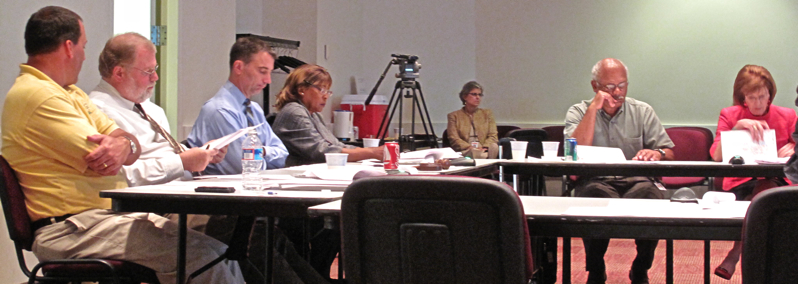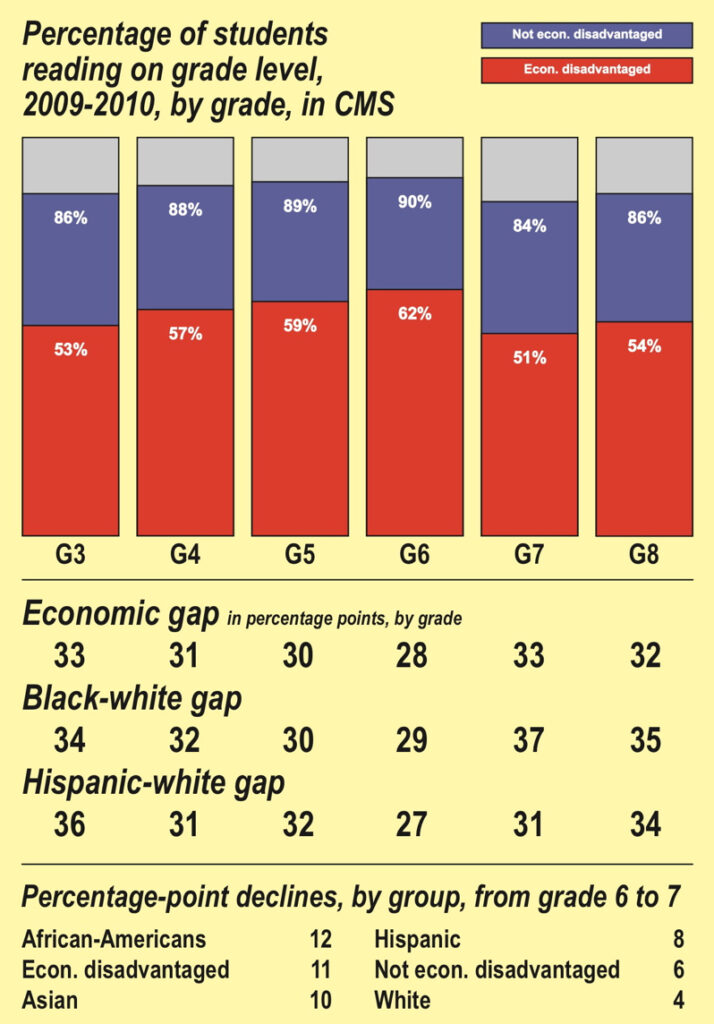
Sept. 9, 2010
Thursday’s school board work session added five elementaries to the list of schools thus far publicly identified as possible targets of change this November.
But a striking feature of the discussion was how often the board faced the prospect of having to fix problems created by previous board decisions.
Not all schools that are on the list, that now numbers 37, are there because of board action, of course. Alexander Middle and Mint Hill Middle are adjacent to land where large residential developments are all set to begin once the economy improves. So staff wants to be careful to prepare space at those schools for the students they expect to show up in the near term.
But most of the schools are on the list because of the cascading effects of previous board decisions. Examples:
– To join the fad for STEM schools (Science Technology Engineering Mathemetics), the math/science magnet at Cochrane Middle was rolled into Morehead Elementary, creating a K-8 STEM. Cochrane, now at 65% of capacity, will drop further as the last of the magnet students cycle out.
– An astounding 910 children exit the 76% poor Hornets Nest attendance area for other schools. Many leave for the magnet at less-poor Winding Springs. The magnet is so close, Supt. Peter Gorman said, that parents wanting to leave “don’t have a proximity issue” – the board has made it easy. Another example: The Randolph magnet makes it easy for nearby McClintock Middle parents to leave.
– The board decision to dismantle a magnet at Lincoln Heights so depopulated the school that 50% of the school is now used as administrative space for Exceptional Children’s Department administrators.
– When Whitewater Elementary opened, some Pawtuckett children were redistricted into the new school. The older school that has served the neighborhood for decades is now the smallest in the system with barely more than 200 students. Its likely closure — or, in Thursday’s lingo, repurposing — is a direct result of board action.
– Pinewood Elementary is on the list because academic gains have slowed after a highly effective principal was swept away, along with some top teachers, for a “strategic staffing” intervention elsewhere. “We’re doing everything right there,” Gorman told the board, ” but at the moment (Pinewood is) not working.”
– At Hickory Grove, a replacement building was built, but the old school was not torn down and in fact is full. Half of the old school’s 34 classrooms serve part of the K-5 cohort assigned there. The other 17 classrooms are filled with pre-kindergarten children who, according to staff planner Mike Raible, were congregated in the available space to free up classrooms at nearby overcrowded elementaries. That decision made sense at the time, but it is board action that has put Hickory Grove at 197% of capacity. (Staff made it clear that they would like to demolish the old building. When board chair Eric Davis asked about moving the pre-K classes to fill up underutilized classrooms elsewhere, Gorman noted that half the old building would still be full.)
But possibly the most glaring single indicator among the schools on the list of 37 is the number of children whose parents have chosen to send their children elsewhere in CMS. They have voted with their children, not their feet, to leave schools they considered inferior for schools they thought would give their children a better chance. And, remember, these numbers do not count the children who leave for private schools or charter schools or home schools – or the street.
Departing from some of the elementaries discussed Thursday: Hornets Nest, 910 children; Pinewood, 434; Hickory Grove, 408; Billingsville, 394; W.G. Byers, 386; Druid Hills, 284; Sedgefield, 277; Irwin Avenue, 141; Westerly Hills, 139; Lincoln Heights, 135; Pawtuckett, 109.
Departing from some of the middle schools discussed Thursday: McClintock, 681 students; Spaugh, 499; J.T. Williams, 495; Wilson, 487; Cochrane, 432; Sedgefield, 336.
These numbers can’t be explained, or improved, without addressing the elephants in the room: race and class. Neither of those terms was used during Thursday’s placid discussion. Staff referred to the need to change the “perception” of some schools.
The board’s sworn task is to provide a sound basic education to every child who wants to attend in Charlotte-Mecklenburg. They will forever fail at their task if they say they want strong neighborhood schools, but then close the weak ones in poor neighborhoods that their own decisions have made weak.
What decisions? It’s a complex web of decisions that defies easy answers or sound-bite responses. Attendance boundaries are routinely used to separate the rich from the poor, the advantaged from the disadvantaged – instantly creating some schools that have extra resources, and others that do not; some that are attractive to teachers and parents, others that are not. Magnet options are created, as mentioned above, to give some parents easy options out of struggling schools while not creating similarly attractive options for other parents. The board has refused to assign staff with the best teaching results to its students with the greatest needs.
All of these and other board decisions have created schools that isolate struggling students, making all but impossible the task of providing each and every one of those struggling students the sound basic education that the North Carolina Constitution requires.







